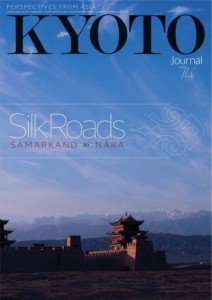 Here is the second in an ongoing series of previews of Kyoto Journal #74 “The Silk Roads”. You can see the previous installment here. In addition to working round the clock to get this edition out by June, the KJ team of saints and angels are also working on issue #75 due out this September. The topic is Biodiversity, and a meeting earlier this week to discuss it generated a lot of excitement – but (!) I shall tell you more about that later.
Here is the second in an ongoing series of previews of Kyoto Journal #74 “The Silk Roads”. You can see the previous installment here. In addition to working round the clock to get this edition out by June, the KJ team of saints and angels are also working on issue #75 due out this September. The topic is Biodiversity, and a meeting earlier this week to discuss it generated a lot of excitement – but (!) I shall tell you more about that later.
Here’s that preview. Enjoy!
Digital Bezeklik ― From a Silk Road cave site, Ryukoku University digitally reconstructs a sacred Buddhist mural, by Leanne Ogasawara

 On the Trail of Texts ― In July 2009 Kyoto National Museum held a special exhibit; “On the Trail of Texts Along the Silk Road: The Russian Expedition’s Discovery of Manuscripts in Central Asia”. Isaac Blacksin interviews the museum’s senior curator of Buddhist manuscripts Eikei Akao.
On the Trail of Texts ― In July 2009 Kyoto National Museum held a special exhibit; “On the Trail of Texts Along the Silk Road: The Russian Expedition’s Discovery of Manuscripts in Central Asia”. Isaac Blacksin interviews the museum’s senior curator of Buddhist manuscripts Eikei Akao.
Alexander Csoma de Kőrösi ― The Grandfather of Modern Day Tibetan Translation by Matteo Pistono
I walk on a thin layer of fresh snow through Tokyo’s Ueno Park. Today I have a meeting of sorts with a man I greatly admire. Many years before while studying at the School for Oriental and African studies, I heard of this man―a Hungarian who walked from Europe to India in search of his ancestors, and in the process became the grandfather to translators of Tibetan Buddhism in the West…
Tibet and Xinjiang ― the New Bamboo Curtain by Parag Khanna
 It is difficult to find a Westerner who does not intuitively support the idea of a free Tibet. But would Americans ever let go of Texas or California? For China the Great Game was neither inconclusive nor fruitless, something that cannot be said for Russia and Britain. Indeed, China was the big winner. Boundary agreements in 1895 and 1907 gave Russia the Pamir Mountains and established the Wakhan Corridor ― the slender eastern tongue of Afghanistan that borders China ―as a buffer to Britain. But rather than cede East Turkestan (Uyghurstan) to the Russians, the British financed China’s recapture of the territory, which it organized into Xinjiang (which means “New Dominionsâ€). While West Turkestan was splintered into the hermetic Soviet Stans, China steadily reasserted its traditional dominance over both Xinjiang…
It is difficult to find a Westerner who does not intuitively support the idea of a free Tibet. But would Americans ever let go of Texas or California? For China the Great Game was neither inconclusive nor fruitless, something that cannot be said for Russia and Britain. Indeed, China was the big winner. Boundary agreements in 1895 and 1907 gave Russia the Pamir Mountains and established the Wakhan Corridor ― the slender eastern tongue of Afghanistan that borders China ―as a buffer to Britain. But rather than cede East Turkestan (Uyghurstan) to the Russians, the British financed China’s recapture of the territory, which it organized into Xinjiang (which means “New Dominionsâ€). While West Turkestan was splintered into the hermetic Soviet Stans, China steadily reasserted its traditional dominance over both Xinjiang…
Beauty and Power on China’s Silk Road ― Military might vs Buddhist compassion, by Sam Crane
The tour guide opened the door and we stepped into darkness. It took a moment for us to adjust visually but slowly, slowly the interior of the small cave came into view. In front of us stood a statue of Buddha, about three meters high, surrounded by swirling painted blues and reds and browns ― flanked by two smaller statues of guardians. The light from the open doorway fell on the Buddha and suffused throughout the space…

And more to come! Deep Kyoto will publish more extracts and images from KJ #74 later next week.
Kyoto Journal #74 is due out in June 2010. PRE-ORDER your copy now at feedback@kyotojournal.org (send name, address, card info) or by SUBSCRIBING to KJ via http://www.kyotojournal.org/subscriptions.html “SILK ROADSâ€.
PRICES: Japan ¥1,500 • US $15 • Canada $15 • EU €10 • Australia $20 • Hong Kong $85 • Korea 20,000KRW.
KJ RETAILING STORES: Where to buy Kyoto Journal in Japan
RELATED:
Kyoto Journal on Facebook
Kyoto Journal #74 First Sneak Preview!
Kyoto Journal #73 – An Anthology of Good Things
Cop10.org website launch